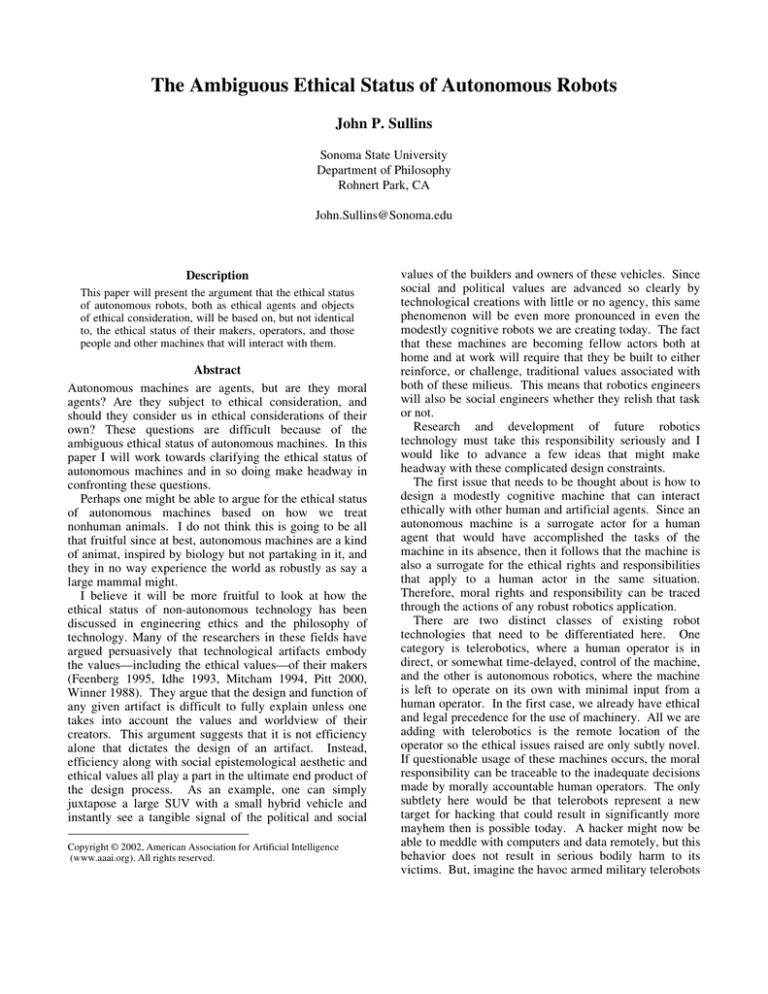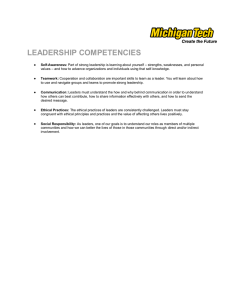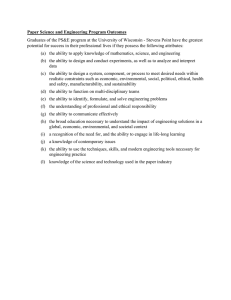
The Ambiguous Ethical Status of Autonomous Robots
John P. Sullins
Sonoma State University
Department of Philosophy
Rohnert Park, CA
John.Sullins@Sonoma.edu
Description
This paper will present the argument that the ethical status
of autonomous robots, both as ethical agents and objects
of ethical consideration, will be based on, but not identical
to, the ethical status of their makers, operators, and those
people and other machines that will interact with them.
Abstract
Autonomous machines are agents, but are they moral
agents? Are they subject to ethical consideration, and
should they consider us in ethical considerations of their
own? These questions are difficult because of the
ambiguous ethical status of autonomous machines. In this
paper I will work towards clarifying the ethical status of
autonomous machines and in so doing make headway in
confronting these questions.
Perhaps one might be able to argue for the ethical status
of autonomous machines based on how we treat
nonhuman animals. I do not think this is going to be all
that fruitful since at best, autonomous machines are a kind
of animat, inspired by biology but not partaking in it, and
they in no way experience the world as robustly as say a
large mammal might.
I believe it will be more fruitful to look at how the
ethical status of non-autonomous technology has been
discussed in engineering ethics and the philosophy of
technology. Many of the researchers in these fields have
argued persuasively that technological artifacts embody
the values—including the ethical values—of their makers
(Feenberg 1995, Idhe 1993, Mitcham 1994, Pitt 2000,
Winner 1988). They argue that the design and function of
any given artifact is difficult to fully explain unless one
takes into account the values and worldview of their
creators. This argument suggests that it is not efficiency
alone that dictates the design of an artifact. Instead,
efficiency along with social epistemological aesthetic and
ethical values all play a part in the ultimate end product of
the design process. As an example, one can simply
juxtapose a large SUV with a small hybrid vehicle and
instantly see a tangible signal of the political and social
Copyright © 2002, American Association for Artificial Intelligence
(www.aaai.org). All rights reserved.
values of the builders and owners of these vehicles. Since
social and political values are advanced so clearly by
technological creations with little or no agency, this same
phenomenon will be even more pronounced in even the
modestly cognitive robots we are creating today. The fact
that these machines are becoming fellow actors both at
home and at work will require that they be built to either
reinforce, or challenge, traditional values associated with
both of these milieus. This means that robotics engineers
will also be social engineers whether they relish that task
or not.
Research and development of future robotics
technology must take this responsibility seriously and I
would like to advance a few ideas that might make
headway with these complicated design constraints.
The first issue that needs to be thought about is how to
design a modestly cognitive machine that can interact
ethically with other human and artificial agents. Since an
autonomous machine is a surrogate actor for a human
agent that would have accomplished the tasks of the
machine in its absence, then it follows that the machine is
also a surrogate for the ethical rights and responsibilities
that apply to a human actor in the same situation.
Therefore, moral rights and responsibility can be traced
through the actions of any robust robotics application.
There are two distinct classes of existing robot
technologies that need to be differentiated here. One
category is telerobotics, where a human operator is in
direct, or somewhat time-delayed, control of the machine,
and the other is autonomous robotics, where the machine
is left to operate on its own with minimal input from a
human operator. In the first case, we already have ethical
and legal precedence for the use of machinery. All we are
adding with telerobotics is the remote location of the
operator so the ethical issues raised are only subtly novel.
If questionable usage of these machines occurs, the moral
responsibility can be traceable to the inadequate decisions
made by morally accountable human operators. The only
subtlety here would be that telerobots represent a new
target for hacking that could result in significantly more
mayhem then is possible today. A hacker might now be
able to meddle with computers and data remotely, but this
behavior does not result in serious bodily harm to its
victims. But, imagine the havoc armed military telerobots
might cause if the control of those vehicle was hijacked in
some way. Thus, the major ethical concern with these
technologies is that every effort must be employed in
securing their control network. The morality of building
telerobots with potentially lethal capabilities will be
directly related to the designers’ ability to achieve secure
and reliable control of the vehicle.
Autonomous robotics is a bit more philosophically
interesting. Since these technologies will deal directly
with humans as fellow agents in our life-world, they will
become immediately entwined in our human
relationships. Much like a family pet is more than just
another animal; a domestic robot might be more than just
another tool.
Existing robotics technology is not cognitively
advanced and is of no threat to Fido’s status in the family,
but if these machines are to be viable in the marketplace
of the future, they are going to have to be programmed in
such a way that they can fit in seamlessly in the life
patterns of the people who buy and use the robot
(Breazeal 2002).
An important part of interacting
socially, involves the ability to make effective ethical
judgments. And while these robots are not robust moral
agents, it can be argued that at an appropriate level of
abstraction they do have the minimum qualities necessary
to be considered moral agents (Floridi and Sanders, 2005).
What kind of ethics and morality we are going to program
these thinking machines with is arguably one of the most
difficult design decisions facing roboticists. This is due to
the fact that unlike telerobots, these machines will be
required to make accurate ethical judgments in our
absence. A robotic vacuum that could sense when it was
being a nuisance and, for instance, knew to treat people
and animals differently from chairs and tables would be a
more positive addition to the home than one that did not
have that capability.
As a preliminary step in that direction I would like to
argue that the ethical status of autonomous robots, both as
ethical agents and objects of ethical consideration, be
based on, but not identical to, the ethical status of their
makers, operators, and those people and other machines
that will interact with them.
What this means is that an autonomous robot is a
machine that stands in place of an otherwise human agent.
As an example, a robotic vacuum takes the place of a
human operating a conventional vacuum, so if a situation
arises such as the pet dog sleeping on a rug that the
machine is trying to clean, the owner of the machine
would want the vacuum to treat the pet in a manner
consistent with how the owner would have done so in that
same situation, perhaps letting the dog lie and cleaning
the rug latter. These ethical deliberations could be done
via a set of weighted prima facie rules that the machine
could access, perhaps choosing the behavior that receives
the best value given the situation at hand. I am hesitant to
recommend this strategy beyond simple domestic robots,
but given the limited ethical impact of these simple
machines this method should give a workable solution.
Of course, even the simple deliberation I used as an
example above requires some impressive AI. The
machine has to know it is dealing with a dog and not just
some obstacle left in the middle of the carpet. Certainly,
the machine does not have to know the dog as a dog but it
does have to behave as if it had this knowledge, perhaps
via RFID or an inference made by motion sound and
infrared detectors located on the machine or built into the
environment in which it operates.
The designers of these systems must be careful not to
assume too much in the construction of these prima facie
algorithms, for instance, assuming that the machine will
always operate in the life world of a standard middleclass
American family. It is often hard to avoid making
assumptions as no one can build a machine that is all
things to all people, and every interesting technology has
unintended consequences once released into the world,
but as long as the operator of the machine is given
adequate ability to assign the weights to the prima facie
rules and perhaps even given the ability to program new
ones, this can be largely mitigated.
I would like to conclude by acknowledging that this
method probably will not scale well. A robotic vacuum
mistakenly bumping a sleeping dog is comical, whereas a
robotic weapons platform mistakenly assessing a threat is
tragic. If we choose to build a robotic platform to work in
dangerous or high stakes situations the only moral choice
at this time is telerobotics and as I argued above, even this
is not unproblematic.
References
Brooks, Rodney, 2003. Flesh and Machines. New York: Oxford University Press.
Breazeal, Cynthia L. 2002. Designing Sociable Robots. Cambridge: MIT Press.
Feenberg, Andrew. 1995. Alternative Modernity. Los Angeles CA.: University of California Press.
L. Floridi, J W Sanders, 2005. "On the morality of artificial agents", Minds and Machines, forthcoming.
Ihde, Don. 1993. Philosophy and Technology. Paragon.
Mitcham, Carl. 1994. Thinking Through Technology: The Path Between Engineering and Philosophy. Chicago:
University of Chicago Press.
Moravec, Hans. 1999. Robot: Mere Machines to Transcendent Mind. Oxford: Oxford University Press.
Pitt, Joseph C. 2000. Thinking About Technology: Foundations of the Philosophy of Technology. New York:
Seven Bridges.
Winner, Langdon. 1988. The Whale and The Reactor: A Search for Limits in an Age of High Technology. Chicago:
University of Chicago Press.




